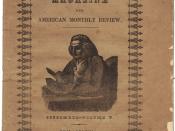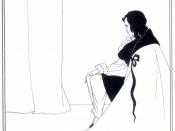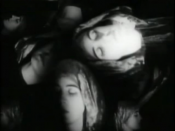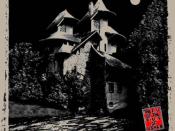Setting, language and the story itself are effective tools in conveying theme. Edgar Allen Poe's "The Fall of the House of Usher"ÃÂ is a strong example of many aspects of a story playing a crucial role in its overall theme. In "The Fall of the House of Usher"ÃÂ, the idea of horror and gloom flows from beginning to end as the story unfolds in the same manner that an Alfred Hitchcock movie might unfold, leaving the reader or watcher in a deep state of visual fright. In film, horror is easily exposed with the combination of eerie background music, gruesome makeup and scary props. In literature however, disturbing scenarios rely physical description, dialogue and manipulation of language. Poe masterfully captures the essence of horror with detailed description of both the physical appearance of setting and character, as well as the suspenseful manner in which he leads the reader to the climax of the story.
The physical setting of the Usher mansion, both on the outside and the inside, conveys a feeling of gloom and death. At first the narrator spends time observing the outside of the house and describes what he sees as "bleak"ÃÂ, "decayed"ÃÂ, "vacant"ÃÂ, "ghastly"ÃÂ, and "gloomy"à(335). These descriptive words help the reader draw a mental picture of the place that he is about to enter. Once inside, the narrator opens our eyes to the depressive and eerie dÃÂécor with descriptions such as "gothic archway"ÃÂ, "dark and intricate passages"ÃÂ, "somber tapestries"ÃÂ, and "phantasmagoric armorial trophies"à(336).
Blelloch 2 By now it is apparent that only horrific things will take place in such a frightful dwelling. Even before meeting the inhabitants of the house, the reader can imagine madmen, monsters or vampires. After all, who else would live in such darkness? The narrator's first impression of the master of the house, Roderick Usher, as a man consumed by madness, adds to the idea that horror is inevitable. Roderick's "cadaverous complexion"ÃÂ, "liquid and large eyes"ÃÂ, and "pallid lips"ÃÂ (337) make the reader feel both pity and disgust when meeting him through the eyes of the narrator. His appearance resembles a vampire's look when he has not had enough blood to quench his thirst. In addition to Roderick's physical appearance, his mannerisms describe a man in danger. He shows "an excessive nervous agitation"ÃÂ (337) and the narrator compares him to a "lost drunkard"ÃÂ and an "irreclaimable eater of opium"ÃÂ (337). At this point of the story we know that this will not be a cordial and pleasant re-acquaintance of long lost friends. The warning signs scream to both the narrator and the reader to run away before horror takes over.
Suspense becomes the most convincing element of horror in "Fall of the House of Usher"ÃÂ. After spending most of the story describing the physical setting and the character's state of dementia, as well as supplying the reader with the disturbed family background, the narrator leads us to the beginning of the end in a long and turbulent passageway of suspense. Climate adds to the feeling of lingering doom as it pushes us to feel "the impetuous fury of the entering gust that nearly lifted us from our feet"ÃÂ (343). We sense danger and feel the narrator's trepidation while he reads passages from his book hoping to avoid the "low and apparently distant, but harsh, protracted, and most Blelloch 3 unusual screaming or grating sound"ÃÂ(345). Our senses are overcome with fear and anticipation, elements of a successful horror story, and we are alert to the sights and sounds of nerve-wracking anticipation. The narrator, Roderick and the reader know that something terrible will soon happen, but when? How long do we have to wait? The element of suspense frightens us more than the impending events. The idea that Roderick will pay the ultimate price for his evil actions do not worry us as much as knowing that we will follow him to his fate.
The idea of horror in film, in literature and in life, is alluring and magnetic. Horror is portrayed everywhere. We watch murderers kill on the big screen. We read stories about demons and vampires, and we watch real-life horrors unfold on the five o'clock news. Although most people will never participate in horrific acts, we nevertheless become drawn to the stories that involve fear. The theme behind these types of stories gives us the same effect as riding a roller coaster, screaming and holding our arms in the air. People love to be scared, and Edgar Allen Poe's "Fall of the House of Usher"ÃÂ delivers.





